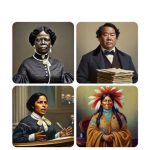Easy Sound Art Exercises
by Victoria Fenner
www.magneticspirits.com
www.soundoutmedia.com
vlfenner@gmail.com
289-396-2742
So What is Sound Art?
Sound art can best be described as art you can hear. It is a multidisciplinary art form which may include music, narrative, poetry, found sound and drama. The skills used in the creation of sound art can be used in many different settings gallery installations, in music, in poetry and dramatic presentations, film soundtracks, or theatre sound design. Works can be exhibited on the radio, on the web, on CD, in the concert hall and art gallery.
Creatively engaging young people in sound production is a way to help them develop their listening skills. When producing anything in the sound medium, creators must first listen to themselves. As the sounds they use expand outwards, they also learn how to listen to other people around them and the rest of the world in general.
This helps foster an aural sensitivity to the sounds of the world which are so often obliterated and overpowered by the mass-produced pre-packaged sounds provided by the entertainment industry. By doing their own audio productions, they also learn that they can also be producers of their own sounds, not just consumers of products created by others.
The field of media arts is quickly opening up to everyone. Over the past ten years, technology has become accessible to the point where it is no longer necessary to have a complex expensive studio to create art works in sound. Much of the work can now be done on ordinary personal computers. Since most young people are comfortable and familiar with computers, this art form is something to which they can adapt easily. The range of possibilities for artistic creation will also appeal to them. Documentary, soundscape, sound poetry, sampled collage and creative personal essay are a few of the possibilities.
The following are a few easy exercises which can be done in the classroom. They don’t require any special technology and are a good way to get students thinking about what they hear.
1.) Electronic Poetry
Ask each student will bring in a piece of poetry. It can be a poem they’ve written themselves or by someone else. Use a couple of examples to brainstorm treatment possibilities as a group, and discuss what kinds of poems lend themselves to sound.
Some of the questions you might ask are:
What is the emotional tone of the poem?
What kind of voice would best suit the poem? (this is a good opportunity to explore some of the voice work they’ve done in drama class.)
Are there references to sounds in the poem which can be illustrated with real sound? (ie. The bell tolled in the distance)
Is there an emotional tone in the writing which can be enhanced through the addition of background sounds?
Can you think of real world soundscapes that would work?
What would work best? Real world sounds or abstract sounds and tones?
2.) Soundscaping
Go on a Soundwalk ideally, this is done as a group. The act of walking as a group reinforces the purpose of the walk .. to listen and to be aware of the sounds around you. To begin, it’s good to start with a short walk. At first, the silence will a bit uncomfortable. Twenty minutes, with a break for discussion at the ten minute mark is a good goal for a first time soundwalk.
Refer to the Handout How to do a Soundwalk by Victoria Fenner. This article will give you a good idea about what to listen for, and how to listen in a focussed way.
Sound journalling give each student a notebook which is large enough to write in, but small enough to be carried in a backpack. Ask the students to begin writing a sound journal. This sound journal can contain anything about sound that they want to write what they hear, what the sounds say to them, memories the sounds evoke .. this is a record of their own listening experience. Choose whatever time frame is appropriate .. the whole semester, a month .. long enough that listening starts to become a habit rather than an isolated exercise.
3.) Documentaries
Listening: Listen to an assortment of documentaries (there are many on the internet). Steve Wadhams, an international award winning radio documentary producer with the CBC Radio Program Outfront uses these five questions when listening to radio docs:
1.) Did you go somewhere?
2.) Did you meet anybody interesting?
3.) Did you learn anything?
4.) Did you feel anything?
5.) Were you surprised?
Discuss the documentaries you heard, and critique their effectiveness.
4.) Painting with Sound
Hearing With Your Eyes have each student choose a work of art that s/he would like to translate into sound. It could be any type of painting — abstract, impressionistic, paintings that tell a story or part of a story, or a portrait . Have the students describe what the painting sounds like to them. You can also take the exercise a step further and ask them to create a short composition expressing the tone, theme, mood or story of the visual art work using simple sounds.
Some On-line Resources:
New Adventures in Sound Art www.naisa.ca a Toronto based group to explore new ways to work with sound. Programming includes youth workshops.
Teen Radio Diaries http://www.radiodiaries.org/teenagediaries.html
Since 1996, the Teenage Diaries series has been giving tape recorders to young people around the country to report on their own lives. They conduct interviews, keep an audio journal and record the sounds of daily lifeusually collecting more than 40 hours of raw tape over the course of a year. The site includes a .pdf copy of Teen Reporter Handbook, an excellent resource for teaching personal storytelling.
www.transom.org – Transom.org is an experiment in channeling new work and voices to public radio through the Internet, for discussing that work, and encouraging more. Great section on tools and techniques including reviews of microphones and recorders.



